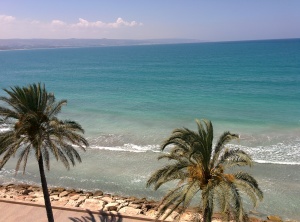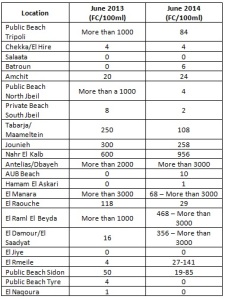Since 2005, the Environment and Development magazine has been monitoring water quality along the Lebanese coast for fecal coliform, which is an indicator that raw sewage is being discharged in the vicinity. These results are published every year to inform the public and help them decide on the upcoming season’s swimming destination. Dr Ghabi Khalaf, director of the National Center for Marine Science, who also perform similar monitoring, explained that the results may differ from month to month or even day to day because of the wastewater flow and other factors such as wind speed.
The table below summarizes the results of the tests in the various areas in Lebanon. The unit of measurement is FC/100ml; which is the number of fecal coliform found in 100 milliliters of water. A level of 50-100 FC/100 ml is considered borderline dangerous and levels exceeding 100 FC/100 ml are considered dangerous. The samples were taken 10 meters from the beach. According to the results of the monitoring campaign, there has been a significant reduction in fecal pollution in the Jbeil public beach, which can be attributed to the removal of a sewage pipeline that used to discharge raw sewage there.
A major reason the coastal water is contaminated with so much Fecal Coliform is because the lack of wastewater treatment facilities in the country. The operation of many treatment plants have been delayed because construction issues, once they become operational there should be a reduction in waste water pollution in the sea.
Click here for the original article (Arabic)
With the absence of proper wastewater infrastructure, the Lebanese coast will always be threatened by pollution. According to the World Bank, about 58% of Lebanon is connected to a wastewater network. The areas with a high FC/100ml are all adjacent to densely populated areas. It is important to keep in mind that this study is only looking into one pollutant. Another issue that should be investigated is the industrial waste pollution in the sea – such as heavy metal concentrations; particularly in industrial areas. Recently the Ministries of Environment and Industry signed a memorandum of understanding to use environmental indicators in the Ministry of Industry; levels of industrial pollution in the sea would be an important indicator to use. In addition, these tests are only conducted one time a year; the frequency of tests should be increased and the coastal waters should be monitored on a regular basis. This would be important to realize the exact impact of the weather and to fully understand the trends of this pollution. The reduction in fecal coliform in many areas compared to last year is a promising sign, especially when there has been widespread pollution in the various water bodies in Lebanon. However, a more robust methodology needs to be in place to ensure the health and safety of the country’s population.


